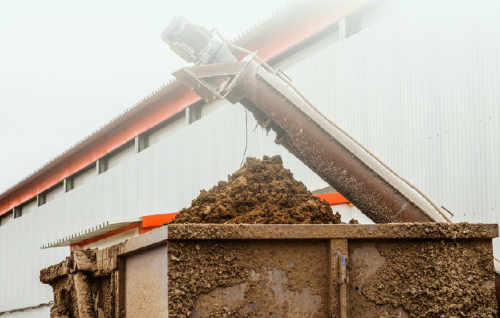Content available at:
Español (Spanish) العربية (Arabic)
INTRODUCTION
Circular economy bases its principles on the longer use of raw materials within a production system to make it more sustainable.
In other words, there is an efficient use of raw materials that allows them to be reused and/or recycled on a constant basis, reducing the amounts of waste.

Therefore, when a product reaches the end of its life, its materials may remain as part of the economy if these can be recycled. Giving them added value, and allowing their reintroduction within the productive chain.
The following items, are some of the major factors associated with this type of economy:
The circular economy model is already widely applied in agriculture and livestock farming. Despite this fact, productive activities such as the poultry industry still produce large amounts of waste.
Countries like Spain alone, produce approximately 12 million tons of fecal waste a year derived from poultry production. This is linked to the fact that chicken is the second most consumed meat in several countries, and eggs are also highly predominant in people’s diets due to their protein content and low costs.
This represents a problematic scenario due to the lack of adequate waste disposal areas. In addition to the environmental impacts associated with greenhouse gas emissions derived from this type of production system (8% of the total GHG emissions attributed to global livestock production).

Therefore, the application of circular economy models allows a better use of waste streams, mitigating their environmental impacts. Making the industry more sustainable and giving “added value” to waste.
The accumulation of feces, feathers, feed residues, litter among others, may be referred to as poultry manure when derived from laying hens or chicken manure when it comes from broilers.

If this waste is not handled properly, it can become a major source of contamination due to the great amount of contaminating molecules that are released, including: non-protein nitrogen in the form of ammonia, phosphorus, hydrogen sulfide, minerals and undigested feed material.
This situation does not only affect the environment, but it also impacts farm workers, and the surrounding communities. Becoming a significant health threat for both animals and humans.
Consequently, one of the current strategies to help prevent this problem,relies on the application of circular economy models where waste is used as fertilizer for crops, compost or for energy production purposes. A practice that benefits poultry systems, agribusiness, people and the environment.

Quiñones (2017), states that processed poultry manure has a positive impact on farm production. Enhancing food supply by improving crop nutritional content as well as increasing their productivity.

In addition, more productive sowings and harvests reduce the need to expand agricultural areas, which contributes towards soil conservation.
In conclusion, the process of transforming poultry excrement for its use in different areas within the agricultural sector, is a highly effective measure that contributes to reducing contamination. Allowing other productive systems to benefit from this practice; reducing waste and obtaining better economic returns.
SECONOV – POULTRY DRYING: REDUCING EMISSIONS AND IMPROVING POULTRY PRODUCTIVITY
SECONOV is an innovative system from Zucami that is making a significant contribution to more sustainable poultry production.
This product is the result of a poultry manure drying process that allows to obtain a high quality organic fertilizer. The use of SECONOV in poultry production allows a more efficient management of all the residues derived from this type of activity. Reducing environmental impacts, while optimizing production.
This system enables the application of a circular economy approach, as poultry manure is turned into a valuable resource instead of being treated as regular waste. Leading towards a better use of natural resources.
¿Looking for a way to improve sustainability on your farm? Try Zucami’s SECONOV and turn poultry manure into a valuable resource.
REFERENCE:
Quiñones, A. T. A. (2017). Producción de biogás para el desarrollo sustentable: experiencias en municipios cubanos. In Congreso Universidad, 6(6). http://revista.congresouniversidad.cu/index.php/rcu/article
Subscribe now to the poultry technical magazine
AUTHORS

Layer Longevity Starts at Rearing
H&N Technical Team
The Strategy for a Proper Infectious Bronchitis Control
Ceva Technical Team
Elevate Hatchery Performance with Petersime’s New Data-Driven Incubation Support Service
Petersime Technical Team
Maize and Soybean Meal Demand and Supply Situation in Indian Poultry Industry
Ricky Thaper
Production of Formed Injected Smoked Chicken Ham
Leonardo Ortiz Escoto
Antimicrobial Resistance in the Poultry Food Chain and Novel Strategies of Bacterial Control
Edgar O. Oviedo-Rondón
GREG TYLER INTERVIEW
Greg Tyler
Insights from the Inaugural US-RSPE Framework Report
Elena Myhre
Newcastle Disease: Knowing the Virus Better to Make the Best Control Decisions. Part II
Eliana Icochea D’Arrigo
Avian Pathogenic E. coli (APEC): Serotypes and Virulence
Cecilia Rosario Cortés
The Importance of Staff Training on Animal Welfare Issues in Poultry Industry
M. Verónica Jiménez Grez
Rodent Control is a Key Factor in Poultry Biosecurity and Sustainability
Edgar O. Oviedo-Rondón